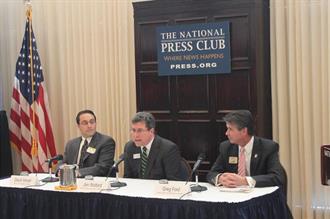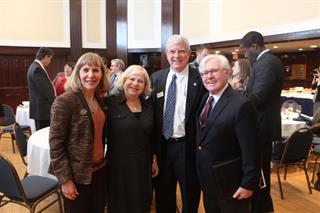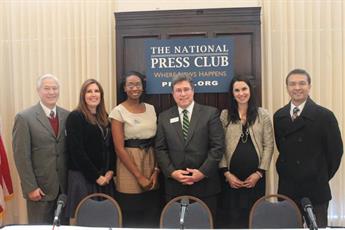Northern Virginia Sidesteps Federal Government Glitches, Leads Regional Economy
Kicking off the year-end regional real estate press conference on Dec. 12, Moderator Jill Landsman, Northern Virginia Association of Realtors® VP - Communications, quoted Washington Post columnist Ken Harney’s glimpse into the future. He said, “2014 should be a more "normal" sort of market for home buying and selling in the D.C. metro area, with a better balance of inventory and demand than we saw in 2013, fewer bidding wars, declining short sales and moderately rising prices.”
Speakers David Versel of George Mason University’s Center for Regional Analysis, Jon Wolford, 2013 NVAR Chairman and Greg Ford, 2014 Greater Capital Area Association of Realtors® Chairman, explained how the market transpired in 2013, and discussed factors that led up to Harney’s market insight.
The regional economy is in transition, said Versel, the first speaker to take the dais. at the National Press Club.
The transitional period has less to do with “government shenanigans,” said Versel, than it does with after-effects of the ‘Great Recession.’
REGIONAL EMPLOYMENT
“The gravy train has stopped for the D.C. area,” said Versel. Federal employment peaked in mid-2010, and those jobs will continue to decline. “We expect the regional economy to keep growing, but not the federal part,” said Versel. Every other sector is expected to grow by 2017, he noted.
“Northern Virginia has been the source of strength in our regional economy, and we expect that to continue,” Versel said. While year-end numbers are expected to show a dip in 2013, Northern Virginia growth is still leading Maryland and D.C.
Versel reported that more than half of the projected new job growth is expected to be in Northern Virginia, which bodes well for the housing market. “People are much less likely to travel across the river now than they used to be,” he said.
Asked about population growth, Versel said that the region is still attracting young professionals, but they will not be driving million-dollar sales. Demand for real estate will be at the lower end of the market. He also noted that much of the new job creation is occurring in lower-paying sectors.
“We can predict what’s going to happen in the future, based on what happened in the past.”
REGIONAL HOME SALE PRICES
Home prices in the D.C. metro area are considerably above where they were one year ago, Versel said. A key factor was the ratio of total active listings to total sales, he explained. “If that ratio is too low, it can spin a market off its bearings,” Versel noted.
Condo prices were a driver in this region, he said, with a 10 percent increase in November 2013, as compared to the prior year. Citing a direct relationship to metro proximity, Versel indicated that economic, generational and cultural factors were fueling interest in condo living.
NEW CONSTRUCTION
A lack of available space near job centers has contributed to the dearth of new construction in the D.C. metro region, Versel said. Beginning in mid- to late 2014, and continuing into 2015 and 2016, residential construction is expected to increase, he added. This is partly due to baby boomer control of 47 percent of the single-family housing units in the region, said Versel, and they have not shown an interest in moving. This apparent desire to age in place, if true, will keep a large part of the single-family inventory locked up for at least 20 years.
 Ford noted the creation of niche markets in D.C. in response to a lack of new inventory. Rehabs are becoming increasingly popular there as consumers seek updated features in an aging inventory.
Ford noted the creation of niche markets in D.C. in response to a lack of new inventory. Rehabs are becoming increasingly popular there as consumers seek updated features in an aging inventory.
In Montgomery County, Ford said that a surge in apartment construction could impact the 2014 market by increasing rental inventory.
COMMERCIAL MARKET
With an absorption rate that has not tracked with employment, the office market in the D. C. metro area is in deep trouble, according to Versel. He cited an increase in telecommuting and a reduction in the amount of required space as two contributing factors. The Government Services Administration budgets 130 square feet of space per employee, compared with 250 square feet that were allotted 10 years ago, Versel said.
 The regional retail market is faring much better than other metro regions nationwide, Versel said. There is a new trend of grocery-anchored shopping centers in urban locations, which are replacing traditional regional malls. These centers are driving new construction, he explained.
The regional retail market is faring much better than other metro regions nationwide, Versel said. There is a new trend of grocery-anchored shopping centers in urban locations, which are replacing traditional regional malls. These centers are driving new construction, he explained.
HISTORICAL MARKET PATTERNS
Acknowledging that sequestration and the federal government shutdown may have temporarily affected the Northern Virginia housing market, 2013 NVAR Jon Wolford explained that market patterns recur regardless of external factors.
“We can predict what’s going to happen in the future, based on what happened in the past,” Wolford said.
Despite a third-quarter contraction in the number of transactions, at the end of November, Northern Virginia posted higher sales and dollar volume numbers than in 2012. This despite rising interest rates and a federal government shutdown.
WHAT TO EXPECT IN 2014
Citing Mortgage Banker Association experts, Wolford said that interest rates can be expected to average 5 percent throughout 2014, closing the year at about 5.5 percent. An increase from 4.5 to 5.5 percent could reduce buying power by $50,000, Wolford said.

Panelists noted that a 2014 increase in FHA down-payment requirements, combined with a decrease in conforming loan limits from $729,000 to $625,000 for the Northern Virginia region could also affect local buyers.
The NVAR Real Estate Finance & Settlement Forum is closely following these and other lending policy changes and will host a spring Finance Summit to explore potential effects on the Northern Virginia market.
Versel’s regional forecast for 2014: evolving economic, employment and population indicators point towards slow and steady market growth.